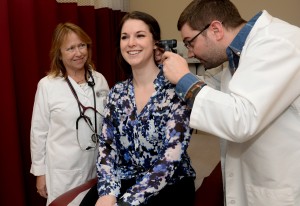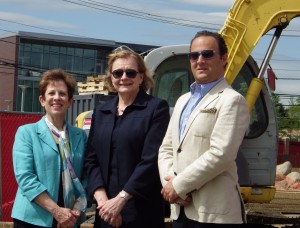Sacred Heart University adapts and grows
From its 1963 founding by now-deceased Catholic Bishop Walter Curtis as a Fairfield commuter school with nine professors and 173 students, Sacred Heart University has grown into a major New England campus, today housing 2,603 students and educating 7,000 across 70 undergraduate, graduate and doctoral disciplines.
Among both its challenges and successes is the engagement of what Vice Provost for Special Academic Programs Mary Lou DeRosa called “the 21st-century learners.”
“We were a sleepy commuter school,” DeRosa said. “But we arrived on the cusp of Vatican II” ”” the Catholic modernization push of the 1960s ”” “and we embraced what was then called the nontraditional learners. Today we call them 21st-century learners.” DeRosa helps shepherd 700 to 800 of these part-time students through their studies during the spring and fall semesters. In the summer, that number shoots up to 1,000.

- Sacred Heart University nursing professor Constance Glenn with family nurse practitioner student Ed Wirkowski, who examines fellow classmate Rachel Schiffres. Photo by Tracy Deer-Mirek
The university in the 1990s was designed around four colleges: arts and sciences, business, health and education, and University College, which is where DeRosa works. Education has since splintered off and is its own entity, the Isabelle Farrington College of Education, making it the fifth college and leaving health as the stand-alone College of Health Professions. SHU”™s new College of Nursing is college No. 6. Each college has its own dean.
The College of Nursing opens July 1, employing 30 full-time faculty members.
“This is the logical next step for our long-standing and rapidly growing nursing program,” said SHU President John J. Petillo in a statement. Mary Alice Donius, current director of the School of Nursing, will be the dean of the new college.
For the fall semester, the College of Nursing will have approximately 500 undergraduate and close to 900 graduate nursing students. About half of the 1,400 students will study online.
DeRosa said the growth of the health and education disciplines grew from market demand. “Nursing is exploding,” she said.
Sacred Heart”™s nursing program was launched in 1980 as an RN-to-BSN program in which registered nurses with nursing diplomas could receive their bachelor”™s degree. To some degree, that is also the model for much of what happens at University College.
DeRosa has partnered with regional companies that include tea giant Bigelow, food services company Chartwells, Bankwell, Cambridge Health and Rehabilitation Center, UIL Holdings, the town of Fairfield, Neopost, CooperSurgical, the Ludlowe Center for Health and Rehabilitation and the Bridgeport Public Schools.
The relationship is more than cutting and receiving checks of support. SHU”™s education partners”™ employees receive a preferential tuition rate when they take classes.
“We”™re seeing a push by employers to have their employees get degrees,” DeRosa said. “It makes the companies more competitive ”” that”™s the business case for it. If employers are moving in that direction ”” toward people with degrees ”” and you are of a generation with a license but not a degree, we work with the business to encourage those employees to go back to school.”

- From left, Sacred Heart University”™s Ellen Kovar, Mary Lou DeRosa and John DeBenedictis beside a dorm under construction. The Frank and Marisa Martire Business and Communications Center is behind them. Photo by Bill Fallon
The school”™s Horizons program helps both Catholic and public school students under the direction of Executive Director Jeff Rumpf. De Rosa is chairwoman of the Horizons board of directors. The program”™s catchment area is Bridgeport and those who join will remain aboard for 12 years until they graduate high school. Horizons is four years old and, as such, its first enrollees are in fourth grade.
University College is also the school”™s center for studying English as a second language, ESL. “We”™re out of the business of competing with the programs in churches,” she said. “I”™m not dissing those programs, but we got out of that. All our ESL faculty are masters-trained and the program is accredited. They are required to be creating a pathway to a higher degree.” Accreditation, she said, is critical when other countries ”” Saudi Arabia, for example ”” pay the bills. “Some countries demand it,” she said. (The University of Bridgeport and the University of New Haven also are ESL accredited.)
The community-themed nature of programs that restart stalled academic careers and that cater to those struggling with the language barrier is evident. DeRosa called it “a shared common interest.”
“We get the full spectrum,” De Rosa said of the 21st-century learners. “We get a lot of students from other schools who might be doing an academic bucket list, taking chemistry and just focusing on that for the summer. We also get students from both ends of the spectrum: students who need an academic boost and those who are super students.”
DeRosa noted SHU events are either affordable or free and said, “A place like Sacred Heart elevates the IQ. It builds community and that is so important.”
Many schools reach out to seniors and alumni as ideal spots to retire. “As a retiree, I would be happy to come to this area,” she said. “Pick your interest and you”™ll find something: lectures on genocide, concussions, a U.S. Senate race.”
DeRosa gathered Ellen Kovar, University College”™s director of corporate recruitment, and John DeBenedictis, recruiter and admissions coordinator for University College, to show off new campus construction. They pointed out the new, $25 million residence hall to open in 2016: 216 beds and 87,000 square feet. Beyond them was SHU”™s glistening, $50 million Frank and Marisa Martire Business and Communications Center, home to the John F. Welch College of Business and to communications and media studies. The Martire toolkit includes a trading floor and professional-caliber production studios.
“Besides jobs and employment, Sacred Heart creates a lot of energy,” DeRosa said to the accompaniment of big earth movers doing their work. “The school is huge as an economic driver. Any day of the week you can come to this campus and there is something to do.”